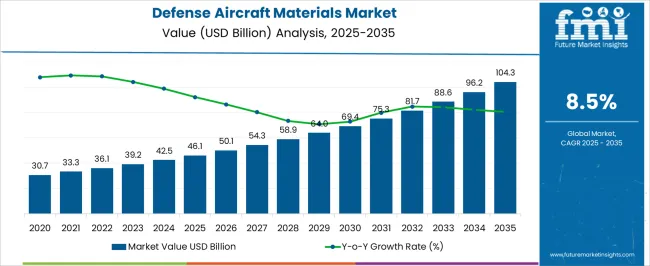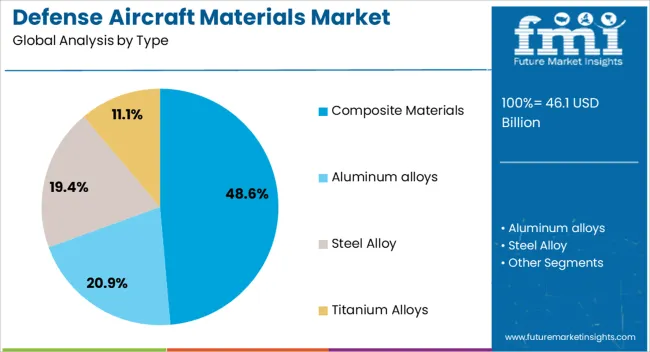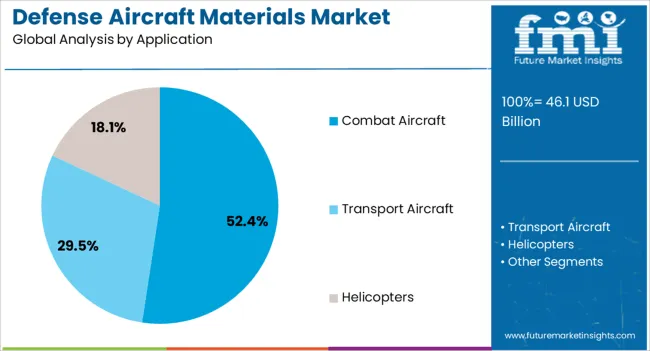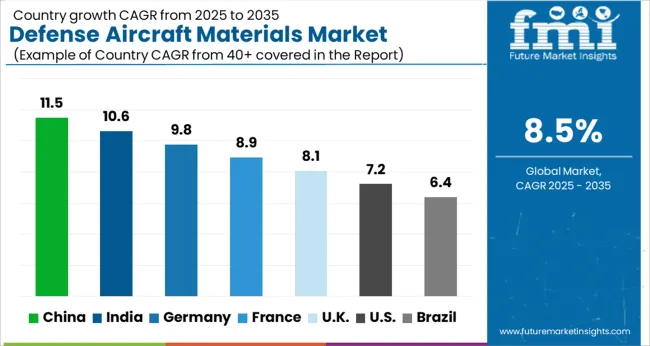The Defense Aircraft Materials Market is estimated to be valued at USD 46.1 billion in 2025 and is projected to reach USD 104.3 billion by 2035, registering a compound annual growth rate (CAGR) of 8.5% over the forecast period.

| Metric | Value |
|---|---|
| Defense Aircraft Materials Market Estimated Value in (2025 E) | USD 46.1 billion |
| Defense Aircraft Materials Market Forecast Value in (2035 F) | USD 104.3 billion |
| Forecast CAGR (2025 to 2035) | 8.5% |
The Defense Aircraft Materials market is experiencing steady growth, driven by the increasing demand for lightweight, high-strength materials that improve aircraft performance, fuel efficiency, and durability in defense operations. The market is being shaped by ongoing modernization of air forces, rising investments in next-generation combat aircraft programs, and the need to extend the operational life of existing fleets.
Materials that provide superior strength-to-weight ratios, resistance to environmental stressors, and enhanced fatigue performance are becoming critical for military aircraft design and maintenance. As defense budgets grow and governments prioritize advanced aerospace capabilities, the adoption of technologically superior materials is being accelerated.
The shift toward more modular and multi-role aircraft has further reinforced the importance of versatile materials that can support structural integrity while enabling integration of advanced avionics and weaponry Future opportunities are expected in the development of next-generation composites and hybrid materials that allow performance optimization without compromising operational reliability, thereby supporting the evolving strategic objectives of defense forces worldwide.
The defense aircraft materials market is segmented by type, application, and geographic regions. By type, defense aircraft materials market is divided into Composite Materials, Aluminum alloys, Steel Alloy, and Titanium Alloys. In terms of application, defense aircraft materials market is classified into Combat Aircraft, Transport Aircraft, and Helicopters. Regionally, the defense aircraft materials industry is classified into North America, Latin America, Western Europe, Eastern Europe, Balkan & Baltic Countries, Russia & Belarus, Central Asia, East Asia, South Asia & Pacific, and the Middle East & Africa.

Composite Materials are projected to account for 48.60% of the overall Defense Aircraft Materials market revenue in 2025, making it the leading material type. This dominance is being attributed to their high strength-to-weight ratio, which significantly enhances fuel efficiency and payload capacity in modern defense aircraft.
The adoption of composite materials has been facilitated by their superior resistance to corrosion and fatigue compared to traditional metal alloys, reducing long-term maintenance costs and improving aircraft lifecycle performance. The ability to tailor mechanical and thermal properties through advanced manufacturing techniques has made composites highly suitable for critical structural components, including fuselage panels, wings, and control surfaces.
Additionally, the integration of composites with advanced coatings and laminates has further improved durability and survivability in challenging operational environments As defense forces continue to demand aircraft that combine agility, endurance, and survivability, the preference for composite materials is expected to expand, reinforcing their leadership position in the market and driving investment in research and development for next-generation aerospace materials.

The Combat Aircraft application segment is anticipated to hold 52.40% of the Defense Aircraft Materials market revenue in 2025, emerging as the leading application area. This prominence is being driven by the extensive modernization of fighter jets, multirole aircraft, and tactical combat platforms, which require materials that can sustain high operational stress while minimizing weight.
The deployment of advanced composites and lightweight alloys in combat aircraft has allowed for improved maneuverability, longer range, and enhanced payload capacity, supporting diverse mission requirements. The growth of this segment is also being influenced by rising defense budgets, procurement of next-generation combat fleets, and the strategic importance of maintaining technological superiority in aerospace operations.
Additionally, the integration of software-defined avionics and electronic warfare systems has reinforced the need for structurally reliable yet lightweight materials As countries continue to invest in cutting-edge combat aircraft programs to meet evolving defense strategies, the demand for materials suitable for high-performance combat applications is expected to remain robust, securing the leading position of this segment within the market.
Defense aircraft materials are high-performance, light-weight materials suitable for aircraft manufacturing. Along with properties such as cost, mechanical performance and ease of installation, other specialized properties are also considered for product selection such as resistance against cracking, thermal shock resistance, thermal expansion, flammability and stealth.
Among all these properties, strength allied with lightness is among the most important properties for defense aircraft materials. Moreover, the reliability of materials under extreme conditions is critical for defense aircraft materials. Aluminum is considered to be ideal for defense aircraft materials, owing to its properties such as light weight, strength and corrosion resistance.
However, defense aircraft materials have witnessed considerable evaluations in the recent years. Defense aircraft materials such as steel and aluminum are increasingly being replaced by low density alloys and advanced composites such as carbon fiber. Composites are the most important materials adopted in the aircraft industry. The global defense aircraft materials market is characterized by innovation and technological advancement, which are driving the industry.
Some of the key driving factors for the defense aircraft materials market include rising global security issues, technological advancements and robust economic growth. Favored by government initiatives and support, the defense aircraft materials market is expected to witness significant innovation over the coming years. Moreover, increase in defense spending by several countries is a key driver factor for the increasing demand for defense aircraft materials.
The defense aircraft materials market is characterized by low competitive rivalry. Moreover, aircraft manufacturers tend to maintain long-term agreements with defense aircraft materials market participants for reliable supply, which further reduces competitive rivalry. Further, close collaborations between defiance aircraft material manufacturers, end-users and government agencies lead to material innovation. Some of the factors that might restrain the growth of the defense aircraft materials market include the high cost of materials and complex production technology.
Technological advancement and development of additive manufacturing & powder metallurgy are among the key factors driving the defense aircraft materials market. Key market participants are investing on the development of sophisticated technologies and high-performance materials so as to strengthen their market positions. Further, in sync with market demand, market participants are emphasizing on the development of lightweight materials.
Other prominent trends observed in the defense aircraft materials market include the utilization of nanotechnologies, incorporation of new materials, fabrication processes and structural concepts to realize performance & cost benefits of defense aircraft materials. Lightweight defense aircraft materials are expected to witness significant growth, driven by the increasing demand for fuel-efficient and long haul aircraft.
North America, led by the USA, is expected to dominate the global defense aircraft materials market. The defense aircraft market in the region is expected to witness significant growth and innovation, supported by increasing government investments in the defense sector and various agencies such a DARPA (Defense Advanced Research Projects Agency). The Asia Pacific defense aircraft materials market is expected to follow the North America market in terms of market size.
Moreover, Asia Pacific is expected to be an opportunistic market witnessing tremendous growth during the forecast period, primarily owing to the increasing government spending on the defense sector by countries such as India and China. The Europe defense aircraft materials market is expected to expand with a steady growth rate and is expected to be characterized by innovation due to the increasing demand for durable, accurate and reliable materials.
Some examples of market participants involved in the defense aircraft materials market are:
The research report presents a comprehensive assessment of the market and contains thoughtful insights, facts, historical data, and statistically supported and industry-validated market data. It also contains projections using a suitable set of assumptions and methodologies. The research report provides analysis and information according to market segments such as geographies, application, and industry.
The report is a compilation of first-hand information, qualitative and quantitative assessment by industry analysts, inputs from industry experts and industry participants across the value chain. The report provides in-depth analysis of parent market trends, macro-economic indicators and governing factors along with market attractiveness as per segments. The report also maps the qualitative impact of various market factors on market segments and geographies.

| Country | CAGR |
|---|---|
| China | 11.5% |
| India | 10.6% |
| Germany | 9.8% |
| France | 8.9% |
| UK | 8.1% |
| USA | 7.2% |
| Brazil | 6.4% |
The Defense Aircraft Materials Market is expected to register a CAGR of 8.5% during the forecast period, exhibiting varied country level momentum. China leads with the highest CAGR of 11.5%, followed by India at 10.6%. Developed markets such as Germany, France, and the UK continue to expand steadily, while the USA is likely to grow at consistent rates. Brazil posts the lowest CAGR at 6.4%, yet still underscores a broadly positive trajectory for the global Defense Aircraft Materials Market. In 2024, Germany held a dominant revenue in the Western Europe market and is expected to grow with a CAGR of 9.8%. The USA Defense Aircraft Materials Market is estimated to be valued at USD 16.6 billion in 2025 and is anticipated to reach a valuation of USD 33.3 billion by 2035. Sales are projected to rise at a CAGR of 7.2% over the forecast period between 2025 and 2035. While Japan and South Korea markets are estimated to be valued at USD 2.1 billion and USD 1.3 billion respectively in 2025.
| Item | Value |
|---|---|
| Quantitative Units | USD 46.1 Billion |
| Type | Composite Materials, Aluminum alloys, Steel Alloy, and Titanium Alloys |
| Application | Combat Aircraft, Transport Aircraft, and Helicopters |
| Regions Covered | North America, Europe, Asia-Pacific, Latin America, Middle East & Africa |
| Country Covered | United States, Canada, Germany, France, United Kingdom, China, Japan, India, Brazil, South Africa |
| Key Companies Profiled | Hexcel Corporation, Toray Industries, Inc., Allegheny Technologies Incorporated, AMG Advanced Metallurgical Group N.V., Arconic Corp., Constellium SE, Henkel Singapore Pte. Ltd, Solvay SA, DuPont de Nemours, Inc., Teijin Limited, AMG N.V., and Solvay S.A. |
The global defense aircraft materials market is estimated to be valued at USD 46.1 billion in 2025.
The market size for the defense aircraft materials market is projected to reach USD 104.3 billion by 2035.
The defense aircraft materials market is expected to grow at a 8.5% CAGR between 2025 and 2035.
The key product types in defense aircraft materials market are composite materials, aluminum alloys, steel alloy and titanium alloys.
In terms of application, combat aircraft segment to command 52.4% share in the defense aircraft materials market in 2025.






Our Research Products

The "Full Research Suite" delivers actionable market intel, deep dives on markets or technologies, so clients act faster, cut risk, and unlock growth.

The Leaderboard benchmarks and ranks top vendors, classifying them as Established Leaders, Leading Challengers, or Disruptors & Challengers.

Locates where complements amplify value and substitutes erode it, forecasting net impact by horizon

We deliver granular, decision-grade intel: market sizing, 5-year forecasts, pricing, adoption, usage, revenue, and operational KPIs—plus competitor tracking, regulation, and value chains—across 60 countries broadly.

Spot the shifts before they hit your P&L. We track inflection points, adoption curves, pricing moves, and ecosystem plays to show where demand is heading, why it is changing, and what to do next across high-growth markets and disruptive tech

Real-time reads of user behavior. We track shifting priorities, perceptions of today’s and next-gen services, and provider experience, then pace how fast tech moves from trial to adoption, blending buyer, consumer, and channel inputs with social signals (#WhySwitch, #UX).

Partner with our analyst team to build a custom report designed around your business priorities. From analysing market trends to assessing competitors or crafting bespoke datasets, we tailor insights to your needs.
Supplier Intelligence
Discovery & Profiling
Capacity & Footprint
Performance & Risk
Compliance & Governance
Commercial Readiness
Who Supplies Whom
Scorecards & Shortlists
Playbooks & Docs
Category Intelligence
Definition & Scope
Demand & Use Cases
Cost Drivers
Market Structure
Supply Chain Map
Trade & Policy
Operating Norms
Deliverables
Buyer Intelligence
Account Basics
Spend & Scope
Procurement Model
Vendor Requirements
Terms & Policies
Entry Strategy
Pain Points & Triggers
Outputs
Pricing Analysis
Benchmarks
Trends
Should-Cost
Indexation
Landed Cost
Commercial Terms
Deliverables
Brand Analysis
Positioning & Value Prop
Share & Presence
Customer Evidence
Go-to-Market
Digital & Reputation
Compliance & Trust
KPIs & Gaps
Outputs
Full Research Suite comprises of:
Market outlook & trends analysis
Interviews & case studies
Strategic recommendations
Vendor profiles & capabilities analysis
5-year forecasts
8 regions and 60+ country-level data splits
Market segment data splits
12 months of continuous data updates
DELIVERED AS:
PDF EXCEL ONLINE
Aircraft Insulation Materials Market
Aircraft Cabin Environment Sensor Market Forecast and Outlook 2025 to 2035
Aircraft Flight Control System Market Size and Share Forecast Outlook 2025 to 2035
Aircraft Electric Motor Market Forecast Outlook 2025 to 2035
Defense Electronic Market Size and Share Forecast Outlook 2025 to 2035
Aircraft Cooling Turbines Market Size and Share Forecast Outlook 2025 to 2035
Aircraft Smoke Detection and Fire Extinguishing System Market Size and Share Forecast Outlook 2025 to 2035
Aircraft Hose Fittings Market Size and Share Forecast Outlook 2025 to 2035
Aircraft Cabin Interior Market Size and Share Forecast Outlook 2025 to 2035
Aircraft Galley Systems Market Size and Share Forecast Outlook 2025 to 2035
Aircraft Interior Lighting Market Size and Share Forecast Outlook 2025 to 2035
Aircraft Battery Market Size and Share Forecast Outlook 2025 to 2035
Aircraft Floor Panels Market Size and Share Forecast Outlook 2025 to 2035
Aircraft Fuel Systems Market Size and Share Forecast Outlook 2025 to 2035
Aircraft Lubricant Market Size and Share Forecast Outlook 2025 to 2035
Aircraft Seat Market Size and Share Forecast Outlook 2025 to 2035
Aircraft Ground Support Equipment Market Size and Share Forecast Outlook 2025 to 2035
Aircraft Maintenance, Repair and Overhaul Market Size and Share Forecast Outlook 2025 to 2035
Aircraft Actuators Market Size and Share Forecast Outlook 2025 to 2035
Aircraft Elevator Market Size and Share Forecast Outlook 2025 to 2035

Thank you!
You will receive an email from our Business Development Manager. Please be sure to check your SPAM/JUNK folder too.
Chat With
MaRIA